Table of Contents
Welcome to our comprehensive guide on organizational culture! This article is a bit longer than our typical pieces, but we promise it’s packed with valuable insights and expert advice from Digital Leadership Partners.
We’ve spent years studying and working with organizations to help them strengthen their cultures, and we’re excited to share our knowledge with you. Whether you’re looking to improve your company’s culture or simply want to learn more about the topic, we hope you find this article helpful. So grab a cup of coffee and get comfortable, because we’re diving deep into the world of organizational culture!
What is Organizational Culture?
Organizational culture refers to the shared values, expectations, and habits that guide the behavior of all employees within a company.
Organizational culture plays a critical role in the success of a company. It sets the tone for how employees interact with each other, make decisions, and approach their work. A strong, positive organizational culture can lead to increased employee engagement, higher levels of productivity, and a better overall organizational environment.
On the other hand, a weak or negative culture can lead to low morale, high turnover, and poor performance. That’s why it’s important for companies to be proactive in shaping and maintaining a healthy organizational culture. One effective way to do this is through the use of tools like the culture canvas, which helps organizations identify and understand the key aspects of their culture and how they can be strengthened.
By leveraging the culture canvas and other similar tools, companies can take a proactive approach to build a culture that supports the overall success of the organization.
Related: Changing Organizational Culture: A Complete Guide
Innovation Culture
A generally well-accepted belief is that a culture that supports innovation is good for a company’s bottom line. Additionally, an innovation culture is highly valued by both leaders and employees in their organizations. Innovation cultures are hard to create and sustain, however. This is puzzling. How can practices apparently so universally favored – and even fun – be so tricky to implement? What’s the secret sauce for a successful organizational culture? How do we properly cultivate an organization’s culture?
Related: Innovation Culture: It’s in the Mindset – Full Guide
Many organizations have installed a wealth of behavioral and structural measures in their quest for a culture of innovation. Adapting organizational structures, creating loft-like workspaces, and introducing numerous training measures to encourage new working methods, among other things. By themselves, however, they are incomplete and can neither create the aspired culture nor the desired behavior in line with the saying: A fool with a tool is still a fool. Ultimately, culture change will not succeed without personal development, as a culture, in the end, is created by the individuals who participate in it.
The Four Lenses of Organizations: How to engage with your innovation team?
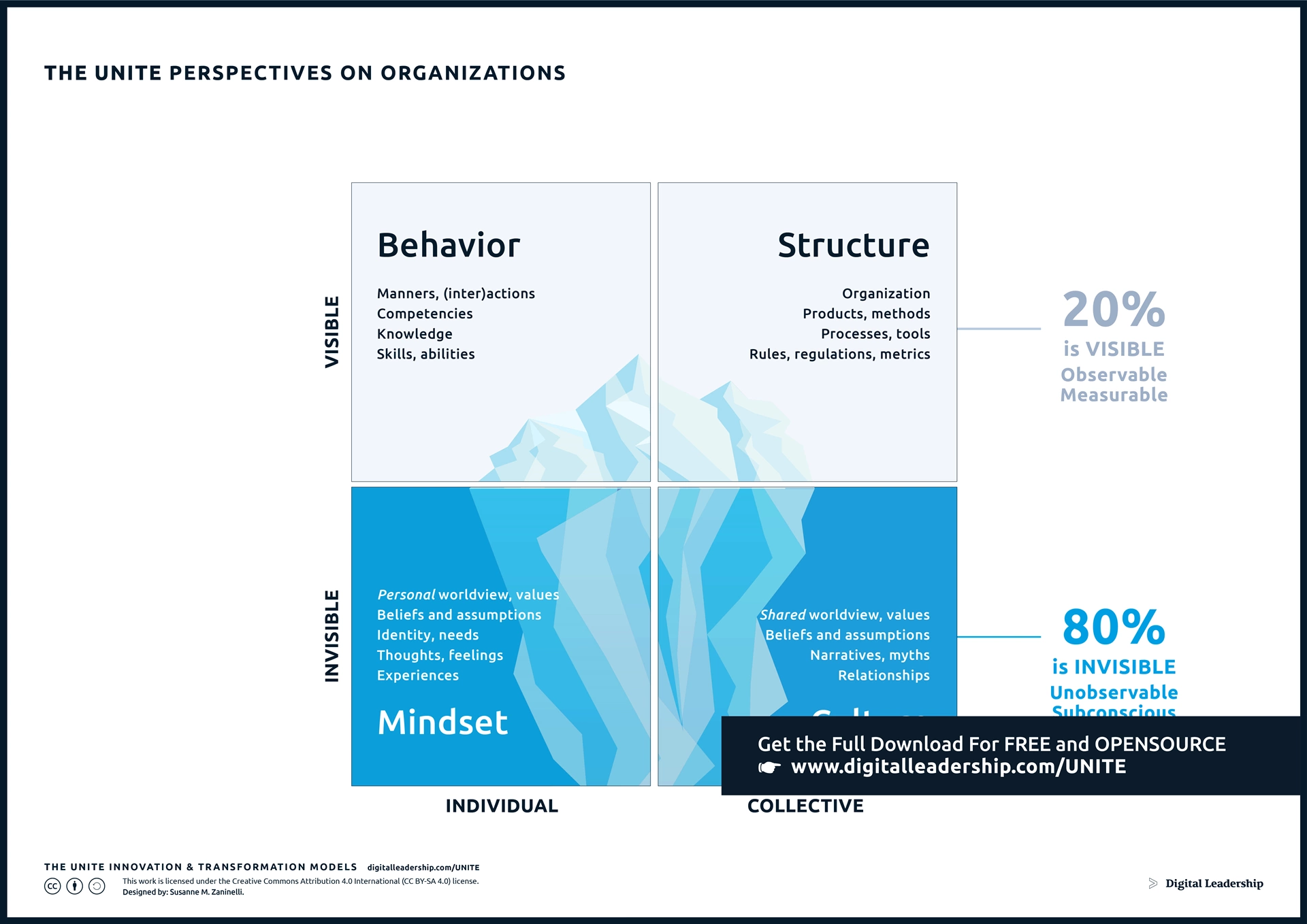
Designed by: Susanne M.Zaninelli
Your download is now available!
You can now access the complete Perspective on Organizations Package, including a full presentation, related models and instructions for use.
Thinking about corporate culture can be overwhelming, especially when we’re concerned with corporate culture change. Impacting a company’s culture can be made easier by thinking about culture overall in terms of lenses and critical domains.
What are the four critical domains you need to engage with to make your innovation team fly?
We divide the four into two groups of two, representing domains that are external and measurable, and domains that are internal and subconscious.
Looking at your cultural traits through these specific lenses helps you focus on making real changes to your workplace culture.
Visible Dimensions in Organizational Culture (Visible and Measurable – How we do things)
Sometimes, our cultural values shine through as a result of observable, measurable attributes. An organization’s priorities are reflected by the organization’s values, and where a company devotes time and resources. The workplace culture must allow for the necessary activities a business needs to complete to meet its mission.
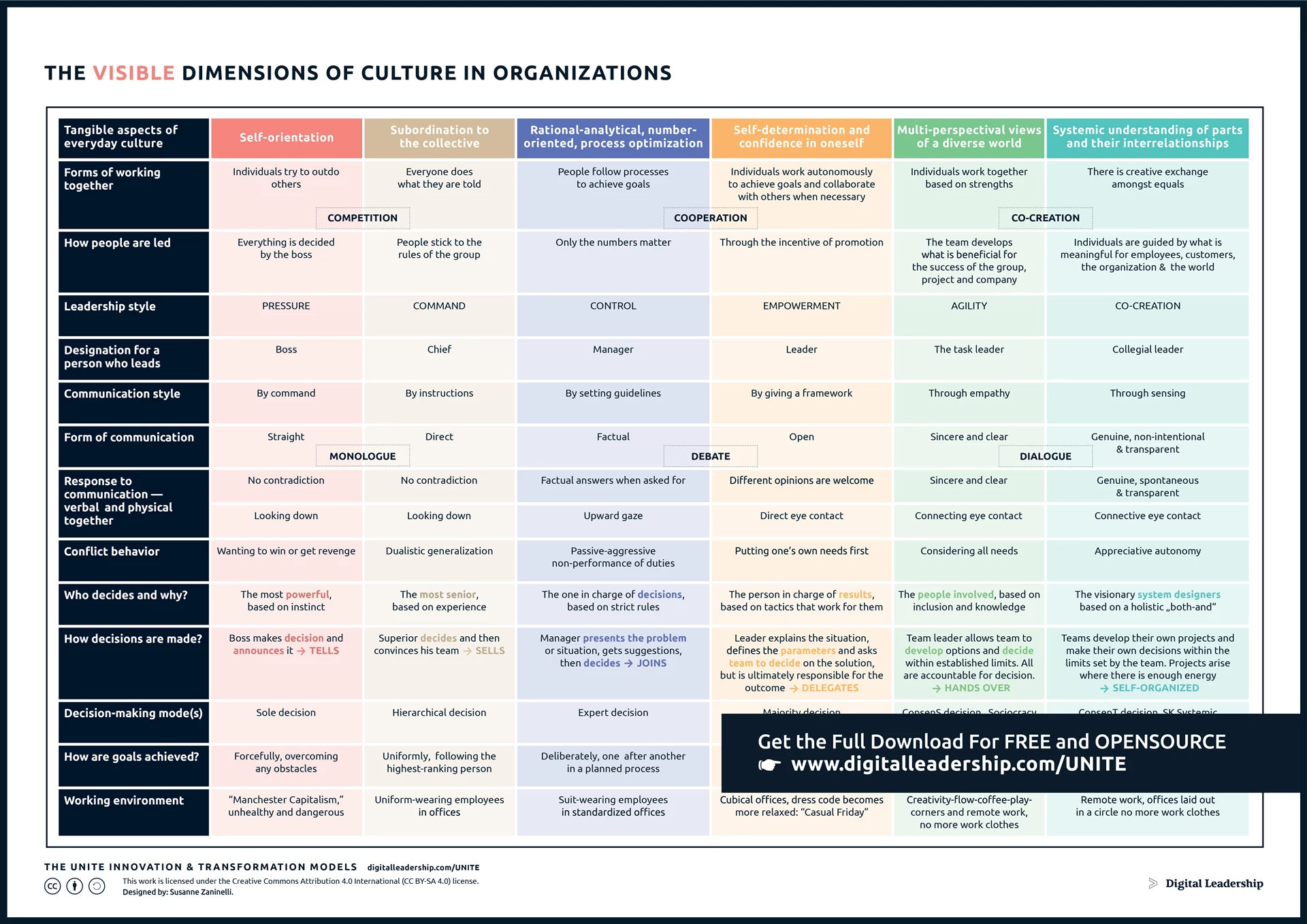
Designed by: Susanne M.Zaninelli
Your download is now available!
You can now access the complete Dimensions of Culture in Organization Package, including a full presentation, related models and instructions for use.
We can start evaluating company culture by examining some elements of how we do our work fairly easily by considering Behavior and Structure.
Behavior
Strong cultures are reflected in the way people interact. Your entire organization should be treating each other respectfully, of course, but importantly, the sort of interactions that are encouraged and required by your business practices.
Strong leadership team members lead by example. They can influence behavior and support organizational change by welcoming employee input and innovation. When the boss is seen as confidently accepting new ideas, chances are other workers will, too.
Structure
Think about the structure and its effect on your business culture in two ways.
How is your business set up physically? Think about where you establish your human resources: not the department, but the actual people. How much employees interact and cooperate might be dependent on simply where they are sitting.
How is your business set up managerially? Is there a clear strategic vision that’s enforced by how your decision-makers communicate and obtain input further down the chain? You can dramatically impact employee motivation and employee engagement just by moving a few desks!
Invisible Dimensions of Organizational Culture (Invisible and Subconscious – Why we think and feel):
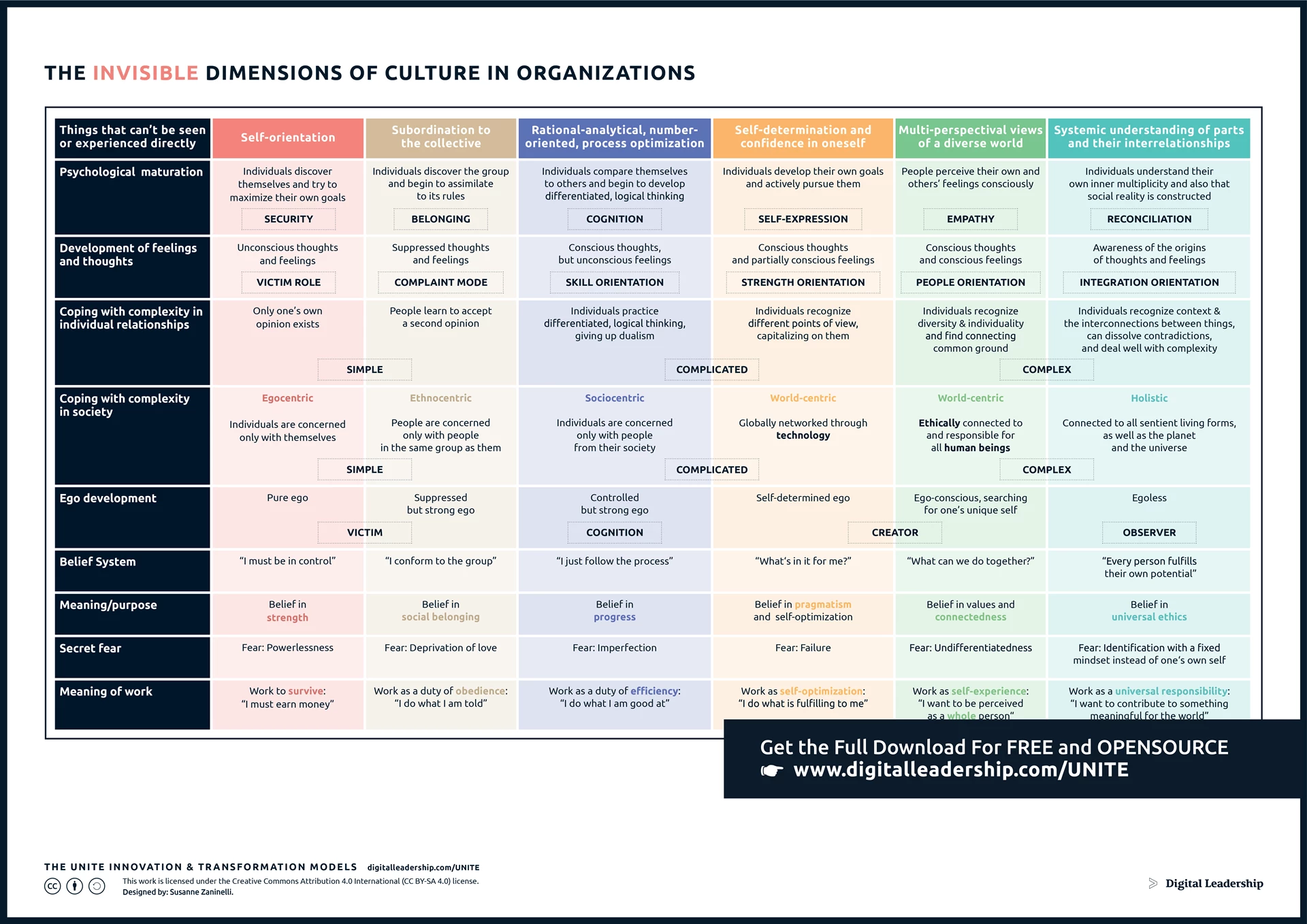
Designed by: Susanne M.Zaninelli
Your download is now available!
You can now access the complete Dimensions of Culture in Organization Package, including a full presentation, related models and instructions for use.
Individual
How we feel within a workplace culture is extremely personal, and one person’s experience could be vastly different from another’s even though their desks are side by side. We all hold some basic underlying assumptions that influence our thinking and how we react to situations.
You can solicit employee feedback to better understand how your workers perceive your workplace culture.
Meaning
Meaning has a strong influence on the perception of your organization. In the current market, customers are asking more and more about the purpose that drives a company and whether it is backed up by the right mindset. Customers do this because they are seeking in the company’s purpose a resonance with their own meaning. Both employees and customers are increasingly critical of organizations that pay lip service to higher purposes while employing mercenary mindsets and exploitative approaches.
Collective
The “collective” culture of your company is the gestalt of everything you do as if the entire organization were one organism.
Employees shape the collective culture and vice versa. As we mentioned before, organizational cultures have visible and invisible components. The collective culture is invisible and works through a set of expectations and peer pressure. In a healthy culture, these motivators are supportive, reward the kind of risk-taking that encourages innovation, and lets everyone go home at the end of the day feeling good about the work they’ve done.
A healthy collective mindset acts as your organization’s immune system. It quashes bad actors and bad behaviors and keeps everything pointed toward the organization’s vision and implementing strategy to work toward the company’s success.
The collective nature of your organizational culture is quiet. It may be hard to identify. Remember that 80% of the iceberg is underneath the water. Like that iceberg, much of what defines your company culture is invisible, underneath the surface.
Rituals
Rituals connect people and communicate mindset, purpose, values, and identity. They are as important as principles and rules for solidifying an innovation culture. They can be particularly effective at transforming the invisible parts of culture, those below the waterline.
In business culture, our rituals are the activities and actions we take over and over. Chances are they’re codified somehow: written down and made official. Perhaps it’s the process for new product approval, or the way hiring is handled. Onboarding very often covers some of the daily and business-centric rituals like employee improvement and matters of ethical and legal sensitivity. Onboarding is also an important moment to socialize with newcomers to your organizational culture.
But rituals aren’t necessarily formally expressed. “Taco Tuesday” might just be something everyone knows happens on the first Tuesday of the month.
Old rituals may need to be rewritten when we’re trying to change our organizational culture. Old habits die hard in the halls of corporate culture; as change agents, we need to take very specific actions to undo past harms and move into the new values we’re trying to focus on.
How Does Culture Change?
The widespread approach of trying to create cultural change through structural change alone is marked by many setbacks and is rarely successful in changing culture quickly and sustainably. Why? Because the root of culture, our collective mindset, is not included. If individuals understand their current mindset, why they need to transform it, and what they are as an organizational culture aiming for, they will be much more likely to “be the change they want to see.”
Just as we cannot force plants to grow through appeals (or threats), we cannot do so with culture. But we can always provide suitable conditions, always keeping all four domains in mind. In other words, we can create supportive structures that allow growth to happen. We can open up space to let the light in. We can fertilize our team culture with the fitting mindset.
Identifying the gaps between your current culture and the culture you aspire to helps you focus and strategize your transition from one state to another. Gaining a solid understanding of how your organizational culture currently operates will be critical in that process. Habits of thinking and acting can be difficult to change; understanding their roots is critical for finding ways to transform them.
If you’re looking to build a new culture, your organization must identify obstacles as well as change agents. A new culture doesn’t develop overnight or without specific strategies. Senior management must buy into the process, along with organization members farther down the responsibility chain. Change agents must ascribe reasonable benchmarks to measure the shift in organizational culture and establish processes to describe overall market cultures.
Truly adaptive cultures rely on a leadership team that is a constant state of evaluation that compares the business’s current organizational culture with other organizational culture types.
When is it Time for Corporate Culture Change?
There’s an easy answer:
It’s always time to work on your company culture. Corporate cultures must be in constant development and redevelopment to keep pace with technology, changing business environments, and shifts in customer need. The business should always be examining its organizational culture to optimize its activities to best meet the needs of its customers.
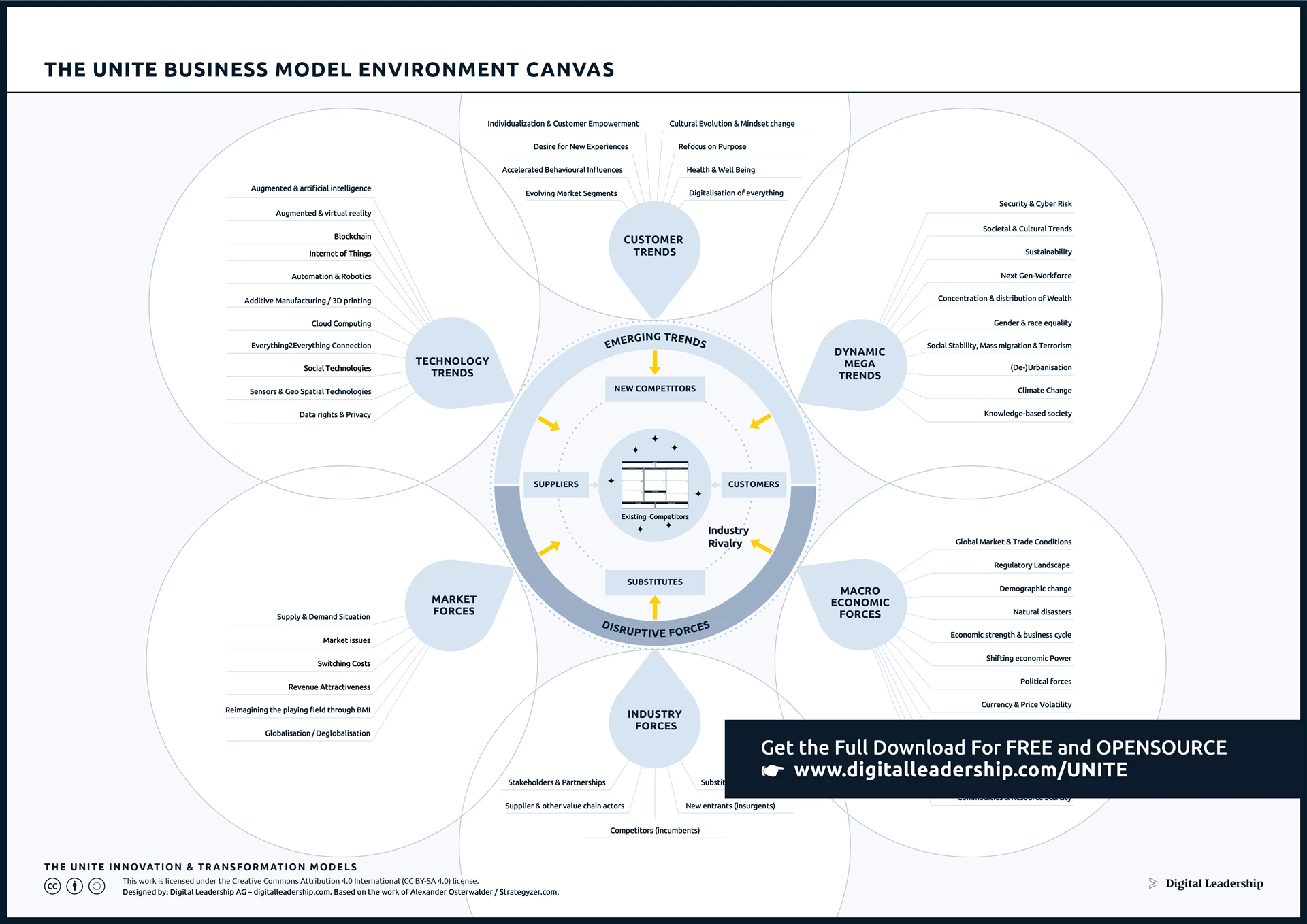
Designed by: Digital Leadership AG – Based on the work of Alexander Osterwalder
Your download is now available!
You can now access the complete Business Model Environment Canvas Package, including a full presentation, related models and instructions for use.
Related: The UNITE Business Model Environment Canvas
Changing your company’s culture
Corporate cultures don’t change overnight, and they don’t change without plans and investment. Because organizational culture affects so many aspects of your business, devoting energy and resources to building your desired culture is worth it over a short amount of time.
We recommend building a company culture that encourages and inspires innovation: it’s how company group and customer satisfaction are built. An organization’s culture will only change, however, through the combined, prescribed efforts of the entire organization.
But how does change happen?
We think there are two categories of drivers that push organizational culture change: internal drivers and external drivers.
Internal Drivers

Designed by: Susanne M.Zaninelli
Your download is now available!
You can now access the complete Evolutionary Drivers From INSIDE Model Package, including a full presentation, related models and instructions for use.
A shift in an individual’s mindset leads them to behave in new and different ways. This inspires others, perhaps because it is meeting new emerging needs, because it is obviously a superior method or because the benefit of adopting this new behavior is actively promoted. When enough people have changed their behavior, it begins to create a new collective mindset. A group of people begin seeing the world differently in a way that is shared (think about the advent of communism or liberalism or how suddenly new projects can gain steam in an enterprise).
This results in different visible structures in the world that emerge from and support that mindset. If these new structures are compelling enough, what was once a cultural shift within a small group transforms into a new normal, like the historical shift from monarchy to democracy or communism.
External Drivers

Designed by: Susanne M.Zaninelli
Your download is now available!
You can now access the complete Evolutionary Drivers From INSIDE Model Package, including a full presentation, related models and instructions for use.
Cultural change can also be driven by outside forces. The change still begins with the individual, but it is sparked by an outside catalyst such as accelerating digitalization. For instance, the invention of the Internet-enabled global interaction. As more individuals integrate the Internet into their lives, they begin to see the world as profoundly interconnected. This changes the way they do things. These people are joined by others and, suddenly, there is a globally competitive, complex, dynamically networked market. This new system begins to collide with long-established business concepts that may no longer be able to meet the values, mindsets, and needs of their customers. In time, the entire culture and its structures shift to adapt to this new mindset.
When we reward employee improvement, we touch on internal and external drives. Company leaders must remember the power of positive reinforcement and make acknowledgment of a job well-done part of their organizational culture and core values.
A successful corporate culture recognizes that an organization is built of individual people who feel valued within the company.
From Hierarchy Cultures to a Network
To understand what drives culture, we first need to understand how our perception of the world, our mindsets, our worldviews, as well as our values and beliefs, evolve. The Mindset Spectrum is an overview that depicts our individual evolution, as well as our team, culture, organizational, and overall business development.
Research into the development of mindset has found that all humans go through developmental stages of inner growth that transform the way we view the world. We develop emotional and cognitive capabilities that allow us to interact with the world in increasingly complex and nuanced ways. Commonly, individuals and organizations that operate based on a particular mindset see that way of looking at things as real, objectively true, and unquestionably fixed. And yet these same people are able to reach a new stage when they are pushed to do so either by internal motivation or by external circumstances.
Cultural change is first and foremost about personal development. On the one hand, individuals are shaped by the environment into which we are born, and our mindset is shaped by the institutions and societies in which we live. On the other hand, individuals need to expand their mindset past those foundational structures in order to enable change, both in themselves and in their organizations.
Thus, in explaining the Mindset Spectrum, we start with our personal development, to better understand ourselves. Then, we show how these mindsets are also found on the collective level in teams, organizations, and societies.
Just as the Mindset Spectrum evolves and exists within an individual, it also applies to societies and companies. As we mentioned before, organizational cultures have visible and invisible components. It’s a good time to once again mention that iceberg and the 80% underneath the water.
When trying to make sense of our individual and collective culture, it is just as important to identify the invisible drivers of that culture. Most of the cultural aspects that you can observe every day (the tip of the iceberg) come from unspoken, and thus invisible, assumptions, values, beliefs, and often fears. Let’s take a look at these invisible aspects so that you can understand and analyze for yourself where your organization is on the spectrum.
When seeking to change the culture of your group, your first task is to work together with your peers to identify the aspects of your current culture. The setting and circumstances will be different in each team; in some, members are coming from similar cultures and therefore can quickly assess their shared organizational culture. In other situations, members may be coming from different cultures, in which case, each person should work individually to identify their own mindset before creating a joint picture of the team’s culture. As we have said, you can use the Culture Canvas during this process as a jumping-off point for thinking about leadership, decision-making, values, principles and rules, structures and communication.
There are many organizational culture types, and you may find that your business shifts among two or more. Since market cultures often change, your organizational culture may be changing, too.
To overcome this tendency to mistake aspiration for reality focus on the visible manifestations of the mindsets. For example, Who leads and how are people led? How are decisions made? How is the conflict resolved? Do these organizational behaviors really match the ideals of the mindset you want to cultivate?
To evolve, we need to become aware of our own mindset, the window through which we view the world, and the unconscious filter we have acquired to decide what is right and wrong. Views and skills we acquired in earlier stages of mindset cannot be skipped or erased. As our abilities to understand and process expand with each mindset development, we are increasingly able to deal with complexity and better understand how different things relate to each other. We learn to sense, identify, and deal fruitfully with our own feelings and needs, and those of others. In this way, we integrate the qualities of previous mindsets, which makes the window through which we view the world wider and wider and our view more and more expansive.
This type of individual personal development is critical for the evolution of culture within organizations. Individuals are the foundation of culture. Our personal abilities stem mostly from what we subconsciously learned in our childhood and limit not only what we can do as individuals, but also what we can achieve as organizations. Changing the organizational culture thus requires personal internal work.
Why do we need an Organizational Culture Change?
Your culture will ultimately have to change, whether you choose to or not. Outside forces such as technological innovation will force any organization to adapt or die. It is obviously better to design your own future than to be shaped for good or bad by external circumstances or luck. Creating a strong culture of innovation will allow your team to successfully navigate the complex, a globally competitive, dynamically networked market that defines our time.
To get you started, we have designed a particularly useful tool: The UNITE Culture Canvas.
Introducing The UNITE Culture Canvas – A Framework to Design Organizational Culture

Designed by: Susanne M.Zaninelli & Stefan F.Dieffenbacher
Your download is now available!
You can now access the complete Culture canvas Package, including a full presentation, related models and instructions for use.
We created the Culture Canvas in collaboration with more than 30 experts from academia and industry to identify and map the key aspects of an organization’s culture. When we set out to understand, describe, discuss, question, shape, and renew our organizational culture, we need a tool that will render culture understandable, tangible, and actionable. The Culture Canvas is such a tool. It enables a group to immediately understand the most important factors and how they interact. Although we will focus on applying the Culture Canvas to the field of innovation, you can apply this canvas to any type of organization culture and any horizon.
Related: The Three Horizons of Growth: A Roadmap to Successful Innovation Strategy
The UNITE Cultural Layers Model summarizes all the layers of your company, from purpose to business outcomes and bottom-line results. Each layer builds on the previous one, and ultimately, all are aligned with the center, purpose. We can thus connect the deep purpose and the other less tangible aspects of culture to the more direct and measurable business outcomes.
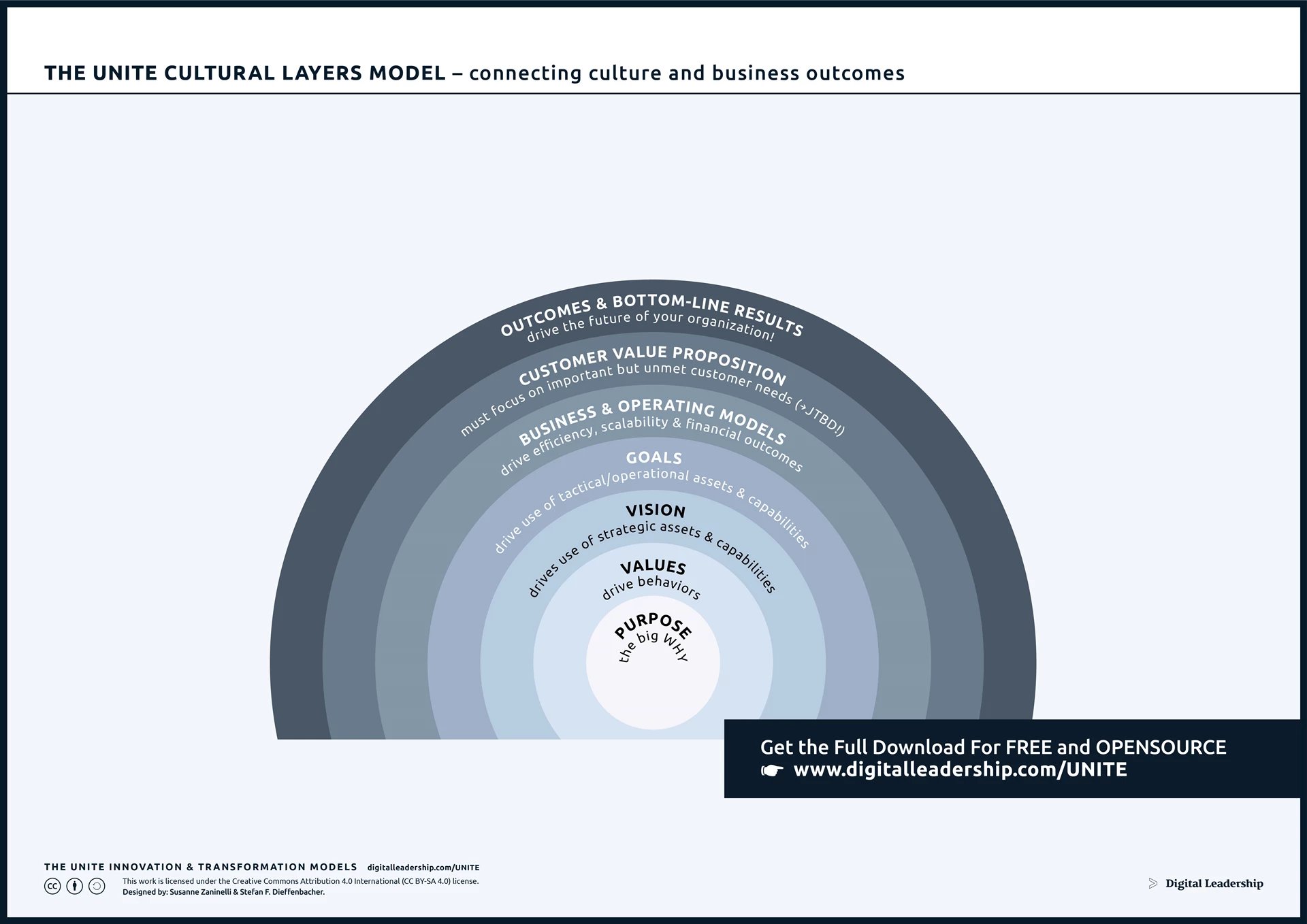
Designed by: Susanne Zaninelli & Stefan F.Dieffenbacher
Your download is now available!
You can now access the complete Cultural Layers Model Package, including a full presentation, related models and instructions for use.
The next layer up from purpose is the core values. Values guide our actions in a more explicit way than purpose does. They translate our overall worldview into actionable principles that can guide our behavior. The layers go on from there. Vision is the long-term goal of the team, what it hopes to accomplish in five to ten years. Goals are set on a more tactical level and are a means to reach the vision. They can be set in any time frame from weeks to years. Our vision and goals are also important because they drive which strategic assets and capabilities a firm invest in. The Business and Operating Models represent how the organization functions and makes money. The Value Proposition is what the customer gets as a result of these models. Ultimately, the Value Proposition creates the business outcomes and bottom-line results – generating an organization’s profit and its current position in the market.
The UNITE Business Model Framework

Designed By: Digital Leadership AG
Download the complete Business Model Framework package, including instructions for putting it to work for you today.
All of our separate model pieces fit into the comprehensive UNITE Business Model Framework. The centerpiece is the Business Model Canvas, which covers the six main areas of a Business Model (the Operating, Value, Service, Experience, Cost, and Revenue Models). The eXtended Business Model Canvas adds the immediate business context, including Business Drivers, customers, and the team, as well as the Unfair Advantage.
Our goal is that every model and canvas we discuss can be placed within the context of your overall business model, no matter where you are in your innovative transformation journey. While the Organizational Culture Canvas is beneficial on its own, using it in conjunction with the complete UNITE Business Model Framework and working through all the canvases we provide will let you realize the maximum advantage possible.
How to Create Innovation includes helpful advice on every aspect of the UNITE Framework, including models like:
- Business Model Canvas
- Value Proposition Canvas
- Operating Model Canvas
- Business Model Environment Canvas
You can claim your free copy of the book by visiting the book section of our website: How to Create Innovation: The Only Book on Innovation you’ll need
Organization’s Cultural Development
Culture lies at the root of what makes a company successful, and yet it can be hard to grasp or define, much less actively cultivate. In many ways, it is like the air we breathe, crucial to our survival, at the same time invisible.
Everyone seems to know that culture is foundational to innovation, citing principles like willingness to experiment, co-creation, tolerance for failure, non-hierarchical structures, and team spirit. Yet, if innovation culture is so important, why do many companies fail to achieve it? One reason is that companies often think they need to change their entire organizational culture to one of innovation. We know from our discussion of the 3 Horizons that this is not always necessary. Every horizon has different goals, operates in a different way, and thus requires a different setup and culture to support its objectives. Therefore, you actually do not want to create a uniform culture across the entire organization. Rather, you want to allow a new innovation-fostering culture to emerge when you are transforming your organizational culture.
We’ve divided your business culture into several areas that you can consider individually.
Personality Development
Your team is made up of people. To engage in the types of self-management, open and non-judgmental communication, and navigation of uncertainty that is required in an innovation context, you need a person who has been and continues to be able to expand their ego development.
So, how do you go about finding these people? The best way is to get them to come to you! In today’s world, innovative systems thinkers are searching for organizations that align with their personal meaning and that have a (Massive Transformative) Purpose that inspires them.
Hiring is a core business process, not a task to be outsourced. People are the lifeblood of any organization, and this is, even more, the case for an innovation-focused team. Human Resources has a critical role to play in managing the process. At the same time, in a green-teal culture, they will no longer be responsible for selecting the best candidates.
Finding the right people is an ongoing project. If you wait to hire team members until you really need them, you’ll be under pressure to hire quickly. Instead, hire the right person when you find them. Excellent team members always pay off.
Cultural and Economic Development
The waves of economic development are driven by invention, most of which is enabled by technological breakthroughs. So, what technologies are creating the acceleration we currently see?

Designed by: Susanne M.Zaninelli & Stefan F.Dieffenbacher
Download the Complete 4 Waves of Industrial Revolution Package, including instructions for putting it to work for you today.
One of the dominant features of the economy over the past 50+ years has been a massive growth in computing power. To understand the exponential evolution of computing power we can look to Moore’s law, the idea that computing performance doubles every two years, while costs remain the same. American inventor Ray Kurzweil calls this The Law of Accelerating Returns and shows that doubling patterns in computation extend all the way back to 1900, far earlier than Moore’s pronouncement, which occurred in 1965.
Cultural and economic development walk hand-in-hand. When you pause to consider it, the strong relationship between the two makes sense. So much of how we adopt and adapt to technology and innovation makes its way into both our culture and how we do business. Successful innovation by definition impacts culture and the economy. Your business must move with it.
Organizational Development
When trying to make sense of our individual and collective culture, it is just as important to identify the invisible drivers of that culture. Most of the cultural aspects that you can observe every day (the tip of the iceberg) come from unspoken, and thus invisible, assumptions, values, beliefs, and often fears.
When seeking to change the culture of your group, your first task is to work together with your peers to identify the aspects of your current culture. The setting and circumstances will be different in each team; in some, members are coming from similar cultures and therefore can quickly assess their shared organizational culture. In other situations, members may be coming from different cultures, in which case, each person should work individually to identify their own mindset before creating a joint picture of the team’s culture. As we have said, you can use the Culture Canvas during this process as a jumping-off point for thinking about leadership, decision-making, values, principles and rules, structures, and communication.
To evolve, we need to become aware of our own mindset, the window through which we view the world, and the unconscious filter we have acquired to decide what is right and wrong. Views and skills we acquired in earlier stages of mindset cannot be skipped or erased. As our abilities to understand and process expand with each mindset development, we are increasingly able to deal with complexity and better understand how different things relate to each other. We learn to sense, identify, and deal fruitfully with our own feelings and needs, and those of others. In this way, we integrate the qualities of previous mindsets, which makes the window through which we view the world wider and wider and our view more and more expansive.
This type of individual personal development is critical for the evolution of culture within organizations. Individuals are the foundation of culture. Our personal abilities stem mostly from what we subconsciously learned in our childhood and limit not only what we can do as individuals, but also what we can achieve as organizations. Changing the organizational culture thus requires personal internal work.
Innovation Development and Your Organization’s Values
It’s time for you and your team to get to work asking yourselves what culture you currently have and what culture you need. Does your organizational culture match the values you’ve decided are important? How do your cultural traits reflect what you value? For example:
- Is employee engagement important?
- How do you value excellent customer service?
- What messages does your compensation structure send?
- How would you measure improved performance?
- How important is your status quo?
- What role does your management team take in ensuring organizational performance?
- Do you favor stability or risk-taking?
Understanding the priorities your organizational culture actually has–in its deeds and not just its words–is a significant element of implementing strategy that encourages innovation.
You can use the UNITE Culture Canvas in a number of ways in this endeavor. We recommend that in the first step, you can have each team member fill in the boxes of the Culture Canvas individually, and then pin the collected results on a blown-up canvas together in a workshop. Then, you can start the group dialogue. What organizational cultures are your team members used to? What mindsets do they represent?
Remember that culture is a process that involves a feedback loop between the individual and the collective. Individuals shape culture and culture shapes individuals. The main ingredients for a successful innovation culture are the mindsets and methods presented here, a strong commitment to self-reflection and open communication in a safe environment, and a willingness to change.
How Can We Help?
Digital Leadership can help you and your company establish the organizational culture that you need to be successful in today’s business environment. Tech companies learned long ago that innovation is a key driver of success, but companies throughout the world and across many sectors can use innovation to optimize their business practices.
An adhocracy culture, a corporate culture based on an ability to quickly adapt to new conditions, has at its core an understanding and drive toward innovation and the importance of testing and reflections. Building a truly authentic adhocracy culture is possible only when new values that reflect this focus are instituted. Such organizations rely on their culture to build safe spaces for innovation, failure, and the thirst for success.
To get a professional opinion of your company’s organizational culture, and to learn how it ranks against other cultures in your business sector.
The UNITE Business Model Framework: A Framework for Innovation Success
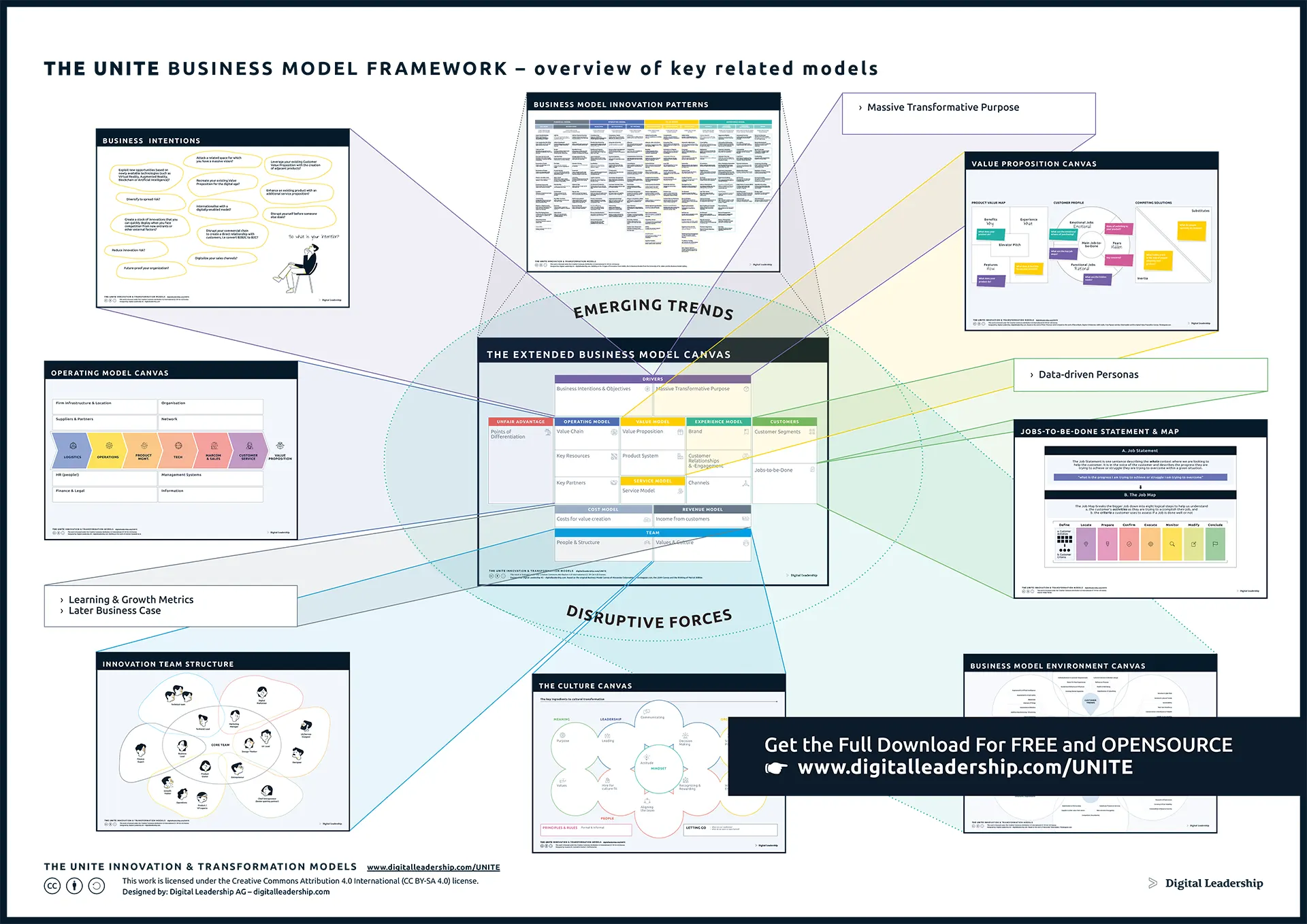
Designed By: Digital Leadership AG
Download the complete Business Model Framework package, including instructions for putting it to work for you today.

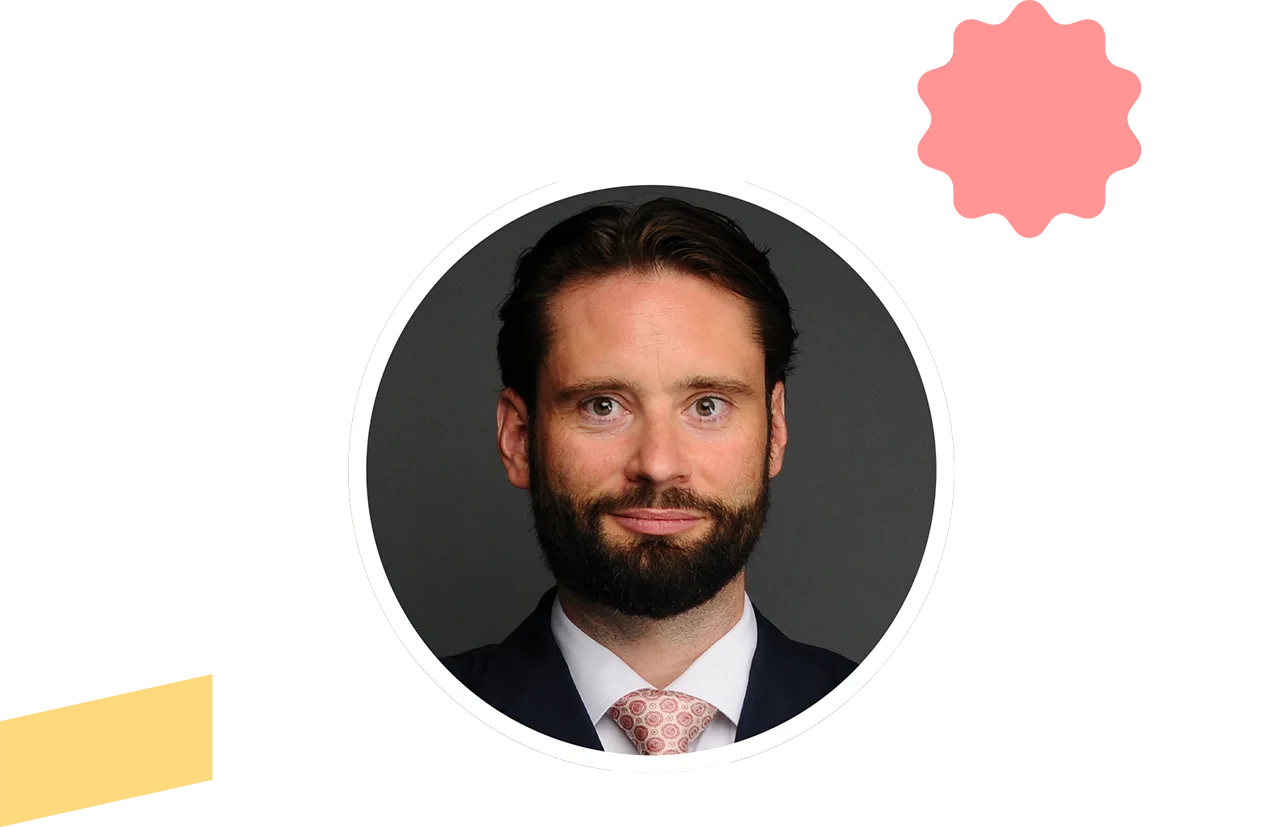



































 Book How to Create Innovation
Book How to Create Innovation